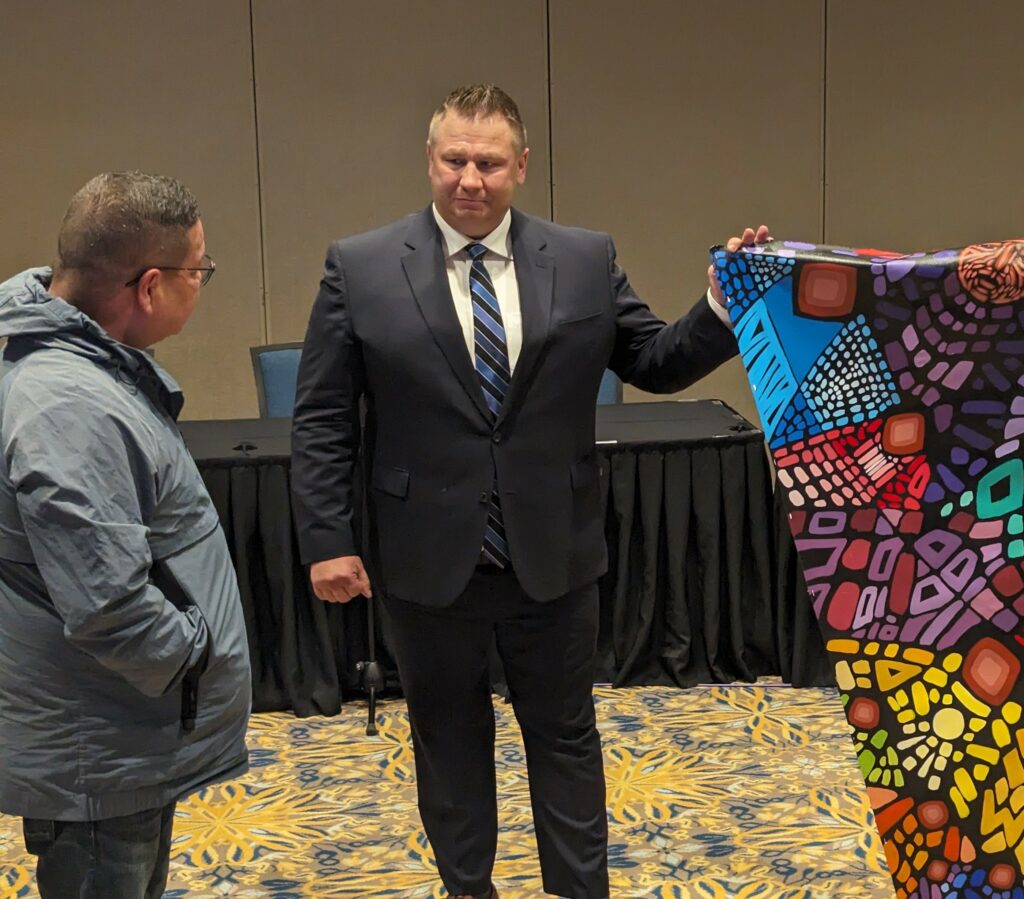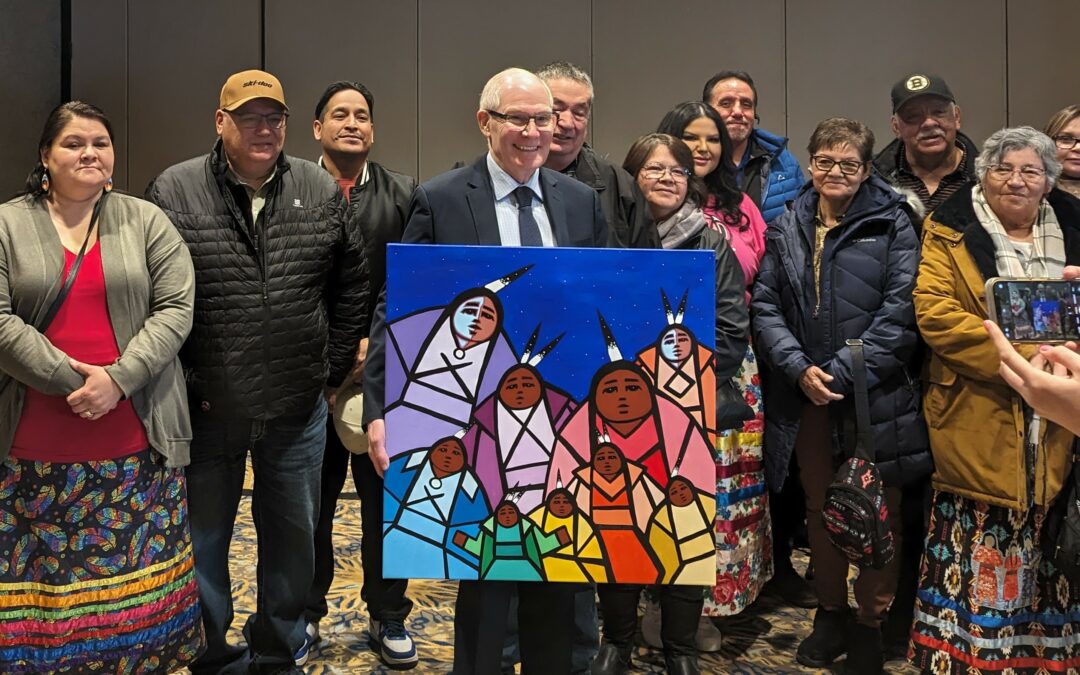(Photo: Saskatchewan’s Chief Coroner Clive Weighill is presented a gift from members of James Smith Cree Nation days before he is set to retire. Photo by Joel Willick.)
The following is coverage from the fourth day of the Coroner’s Inquest into the manhunt, apprehension, and death of Myles Sanderson.
Coverage of the first three days of the inquest can be found at the following links: Day 1 – Day 2 – Day 3.
Content Warning: Some of the following details may be distressing
Recommendation/inquest reactions – 8:04
After the jury rendered their verdict and recommendations, members of the inquest, leaders from James Smith Cree Nation, and the head of the Saskatchewan RCMP provided their response.
Inquest counsel Tim Hawryluk says the two inquests on the mass stabbing on James Smith Cree Nation and in Weldon over the past two months have been the most challenging and rewarding of his career.
He says a highlight for him was members of James Smith Cree Nation embracing RCMP Cst. Heidi Marshall at the conclusion of her testimony. Marshall was the officer who performed the successful pit maneuver disabling Sanderson’s vehicle.
“The circumstances have been extraordinarily difficult for the families in particular and law enforcement. To see that bridge being built back between law enforcement and the family was a particularly powerful moment I believe,” said Hawryluk.
The director of justice for James Smith Cree Nation says this week’s inquest has helped bring closure to the community.
Eddie Head, who had standing at the trial because he is the uncle of Sanderson, says it was important that the community saw that Sanderson died of his own accord and not by any fault of the RCMP.
“The team that they put together, they were trying to save his life,” said Head. “That was really important for the James Smith members who came here, to understand… the RCMP members did their best to try and save him.”
James Smith Cree Nation Chief Wally Burns also spoke on the healing nature of the inquest. Burns says he will continue to push for a national inquiry, First Nations administered policing, and healing for his community.
Rhonda Blackmore, the head of the Saskatchewan RCMP also spoke with reporters about her response to the recommendations.
“I think the recommendations were very relevant to the incident as it unfolded. We have to remember this incident was an incredibly very high risk incident outside of what we would see in day to day policing,” said Blackmore. “We will take those recommendations back, we will review them and look at where we can implement them, and what we can do to address the recommendations.”
Blackmore says the RCMP will be releasing their own internal report on the incident in the coming weeks.

(Photo: Coroner’s Councel Tim Hawryluk fights back tears as he is presented a gift from Chief Wally Burns of James Smith Cree Nation at the conclusion of the inquest. Hawryluk says the gift is something he will “cherish” for the rest of his life. Photo by Joel Willick.)
Jury Findings and Recommendations – 6:23
After deliberating for around 5 hours the jury came back on Thursday evening with their findings and recommendations.
The jury determined:
Myles Sanderson died by accidental death due to acute cocaine toxicity.
The jury would then provide 4 Recommendations – 1 to the Saskatoon Police Service and 3 to the Saskatchewan RCMP.
They are as follows:
- To the Saskatoon Police Service that the SPS consider establishing a dedicated team to arrest individuals with outstanding warrants.
- To the RCMP – consider implementing mandatory enhanced driving training including pit maneuvers.
- To RCMP – that the RCMP consider a review of policy and criteria in a high-speed pursuits in interest of safety to all involved.
- 4 to RCMP – Consider implementing additional training in the form of enhanced extraction techniques for the purpose of arrest takedowns.
12:30
Inquest Coroner Robert Kennedy charged the jury with their responsibilities.
He reminded them that their responsibility will be to determine how Myles Sanderson died and by what means. They will also have an opportunity to provide recommendations on the matter.
Kennedy reminded the jury their duty is not to find fault in the matter as it is not a criminal trial. He says their findings and recommendations should only be based on evidence they have heard at the inquest.
The jury will now deliberate on their findings and recommendations with an expectation their verdict will be announced Thursday afternoon.
11:12
The final witness of the inquest was Dr. Matt Logan, a retired RCMP doctor who performed a post-mortem behavioural report on Sanderson. Logan testified at the inquest via video.
Logan is a Phd. criminal psychologist. The inquest filed Logan’s report on Sanderson as evidence at the inquest. His report was presented in more detail at the inquest in Melfort in January.
Logan detailed exactly what a post-mortem behavioural report is. He described it as an analysis of a person or a type of psychological autopsy. It tries to develop a clear picture of who the person was, their behaviours, and why the person was in the place they were.
The report speaks on Sanderson’s difficult childhood, that was full of abuse and instability. Logan described these as “adverse childhood experiences.” Logan says Sanderson’s employment was very sporadic in adult life. Sanderson completed education to Grade 9 and was suspended a number of times and had many truancy issues. The RCMP doctor detailed Sanderson’s lengthy criminal history, which included 59 criminal convictions. Sanderson was in a number of institutions as a result of these convictions. However, Logan says Sanderson seemed to do rather well in his time spent as an inmate in these facilities.
Logan then documented Sanderson’s drug abuse, which he says started at 13. Logan says it appeared Sanderson’s drug of choice was cocaine, which Logan says he used “considerably.”
Logan spoke on Sanderson’s psychological history. He says Sanderson had one suicide attempt in his life while at Saskatchewan Penitentiary. He says Sanderson was treated for ADD. In Logan’s view, Sanderson would be considered a psychopath. Logan says the term is often misused, but Sanderson displayed signs of that type of behaviour. He says Logan scored a 33 out of 40 in the test profile for psychopathy putting him in the 94th percentile.
“He was in a very high category,” said Logan.
Logan then spoke on Sanderson having a mission type of criminal behaviour, which he says is common of mass killers. He says often these types of events are planned in some fashion, often with a goal of revenge. Logan says Sanderson’s mass stabbings was a mission orientated crime where Sanderson’s victims were chosen because of a loose association with the “Terror Squad” gang.
The inquest then focused on the home invasion Sanderson undertook in a rural area near Wakaw where he would steal the 2008 white Avalanche. Sanderson had threatened the woman in the home. In Logan’s opinion, Sanderson wasn’t interested in physically harming people who had nothing to do with the Terror Squad or were not apart of his mission and he only wanted food and a vehicle. Logan believes because she complied with Sanderson’s demands he let her live. At one point Sanderson had asked the woman to come with her in the vehicle. Logan says he does not believe Sanderson wanted her in the vehicle as a hostage, but that her presence in the vehicle would make things less suspicious.
Logan described Myles Sanderson’s interaction with Richard Sanderson on One Arrow First Nation in a similar way.
Logan then discussed the high-speed chase on the wrong side of Highway 11, which he described as Sanderson showcasing “death ambivalence”. Logan says this was Sanderson showing he didn’t care whether he lived or died. Logan was asked why Sanderson did not strike any vehicles and he says Sanderson believed the “mission wasn’t over” and that Logan believes there was someone else in Saskatoon to finish the mission. Logan believes the final part of Sanderson’s “mission” was to kill his ex-wife.
Logan believed Sanderson’s death was accidental overdose saying Sanderson was taking the cocaine not necessarily to die, but that he didn’t care if he did die. Logan provided his opinion as to why Sanderson didn’t attack RCMP officers at his arrest, which Logan says he didn’t want to go out in a “blaze of glory.” Logan believed Sanderson was heavily affected by the cocaine and he was ambivalent about whether he died or not. His opinion on Sanderson’s cocaine ingestion is that there is a possibility that Sanderson specifically tried to die by suicide, however, he did feel it was Sanderson showcasing signs of “death ambivalence. He says the way Sanderson acted in the moments after his arrest also fits this description.
Logan was asked if Sanderson’s situation was treatable. He says while Sanderson couldn’t be cured, treatability is possible, however Logan says it is rare to see someone with this type of psychopathy to be treated correctly.
9:56
The first witness on Thursday morning was Dr. William Papenfus, the presiding doctor at the Royal University Hospital who declared Sanderson dead.
Dr. Papenfus says the trauma team was first notified that Sanderson was coming in as a patient, so a room was prepared for his arrival. Papenfus says the presiding ER doctor is not usually involved if a trauma team is activated.
The ER doctor says Sanderson was called in as a generic patient and it came in quickly that it was Myles Sanderson and it wasn’t a trauma related event, so he was called in to accept Sanderson into the hospital.
Papenfus says life support was continued on Sanderson as he was moved on to a hospital. At this time, Sanderson begins being assessed by the medical team at the hospital. He says they also heard Sanderson might have ingested an unknown white powder and went into cardiac arrest shortly after.
The doctor says the paramedics took the appropriate measures to treat Sanderson based on the medical emergency he was in.
Papenfus says the hospital staff determined with an ultrasound that there was no heart activity.
Sanderson would be declared deceased by Dr. Papenfus at 4:39 p.m. on September 7, 2022 at Royal University Hospital in Saskatoon.
6:00
The inquest into the manhunt, arrest, and death of Myles Sanderson is entering its final day of testimony.
Two people are set to conclude the testimony portion of the inquest on Thursday morning; the ER doctor who called time of death and a doctor, who is also a retired RCMP officer, who conducted a post-mortem behavioral analysis report of Sanderson.
Following the conclusion of testimony the 6-person jury will begin deliberations to provide their opinion on how Sanderson died and to make any possible recommendations for any organizations involved.
